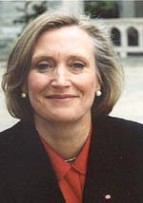Symposium Features Canadian Minister of Health
 Fact: Forty-five million Americans go without health insurance.
Fact: Forty-five million Americans go without health insurance.
Fact: Every Canadian receives universal health care coverage.
Fiction: Both countries have few worries when it comes to providing for the health and well-being of their citizens.
The United States and Canada share a vast northern boundary and a common language. Yet these two nations couldn’t be farther apart in the way they approach their health care systems. Hoping to inform and educate, the Canadian Consulate General in Chicago sponsored a symposium, “The Canadian Health Care System: Facts, Not Fiction,” at Northwestern Memorial Hospital on January 28. Hosted by the Feinberg School of Medicine, the half-day seminar featured a variety of guest speakers and a keynote address from Canada’s Minister of State for Public Health, Carolyn Bennett, MD.
The government of Canada grapples with all too familiar national issues such as rising health care costs and an aging population much like the United States, according to Anne Charles, Consul General of the Canadian Consulate General in Chicago. Opening the program, Charles said, “How we choose to deal with these challenges is critical to both sides of our border.” And clearly understanding Canada’s single-payer health care system is the first step toward exchanging ideas as many myths abound. “Many people, for example, think we have socialized medicine,” remarked Charles. “In fact we pay for our health care through our taxes. I can assure you the system is not free.”
Northwestern professor and director of the Health Industry Management Program at the Kellogg School of Management, Joel I. Shalowitz, MD, MBA, gave an overview of the history of Canadian health care and the Canada Health Act that forms the basis of that country’s health care system today. The act—unanimously passed by Canada’s Parliament in 1984 and known as “medicare”—contains five key components: public administration, comprehensiveness, universality, portability, and accessibility. For all Canadians this legislation provides public insurance covering health care services, ranging from preventive to emergency care, anywhere in the country’s 10 provinces and three territories. Federally funded, the system relies on local governance. Third-party payers do not exist.
“We have a lot in common with Canada, but we also have differences,” said Dr. Shalowitz, who was a Fulbright Scholar at York University in Toronto in 2003â04. “We must also realize that some aspects of the Canadian system are not culturally compatible, but there are other elements that we can share.”
Canadians pay less for prescription drugs and have some peace of mind that they can afford health care services. Yet critics charge they also face long waiting lists and delays for elective procedures. In addition, patients may not have access to the latest technology and research as they might in the United States. While concerned about the sustainability and responsiveness of their health care system, Canadians remain proud of its core values: equity, fairness, and solidarity, according to the final report of the Commission on the Future of Health Care in Canada—a crucial blueprint for health care reform in Canada.
“Canada’s health care system is a statement of ‘we-self’ rather than ‘me-self,’” explained speaker Robert Y. McMurtry, MD, professor at the University of Western Ontario and a member of the Health Council of Canada. “There is a notion that we are all in this together.”
The symposium also covered the experience of the province of Quebec in administering health care to its constituents and the future of health care in Canada. James E. Calvin, MD, director of the Section of Cardiology at Rush University Medical Center in Chicago, gave a provider’s perspective of practicing under the Canadian system. Born in the United States and raised in Canada, where he received his medical training, Dr. Calvin discussed the pros and cons of the two countries, which have similar mortality rates. From a physician’s vantage point, he shared, “In Canada, I didn’t feel micromanaged as a physician and didn’t have to ask for permission to perform diagnostic tests.” On the other hand, Dr. Calvin stated that dissatisfaction with limited research funding and lower salaries—among other things—have Canadian physicians “voting with their feet.”
A family physician in Toronto before her election to Canada’s House of Commons in 1997, Dr. Bennett spoke about the mission of public health in Canada to keep people well and “put the ‘health’ back into health care.” Last May she announced the creation of a new Public Health Agency of Canada to deal with epidemics of chronic disease as well as serious infectious diseases.
“The outbreak of SARS was a wake-up call for Canada,” revealed Dr. Bennett, author of Kill or Cure: How Canadians Can Remake Their Health Care System. “It is no longer good enough to wait for people to get sick and then start looking around for enough ‘repair shops’ to take care of them.”
Appointed to her current position in 2003, Dr. Bennett discussed the role of her branch of the government in improving the delivery of health care services. She also spoke about her goal to “fix” a system of universal health care that so many Canadians consider a critical and necessary part of their national identity.
“Citizen engagement is crucial,” said Dr. Bennett. “Only when we have citizens pushing public policy are we able to pull the strings.”






